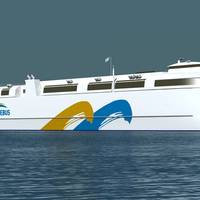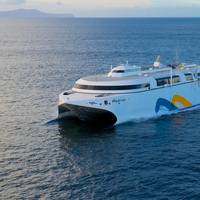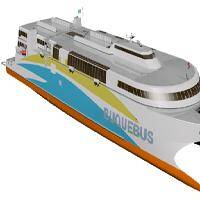Incat to Build World’s Largest Aluminium Ship

Australian shipbuilder Incat said it has secured a contract to build the world’s largest aluminium ship.Incat Tasmania Pty Ltd will build the 130 meter long ship for long standing customer, Buquebus to operate between Argentina and Uruguay.The completed vessel will be the largest aluminium ferry ever built and the ninth vessel for Incat’s valued South American customer.The 130-meter ferry will join the other Incat ships already serving various ports on the River Plate (Rio Plato) between Argentina and Uruguay.At a probable 13…
Incat Ferry Order from Denmark
Incat Tasmania Pty Ltd, Australian shipbuilder, has secured a contract for the construction, delivery and long term charter of a large fast vehicle ferry for Danish company Mols-Linien A/S. The Ferry will be the fourth Incat vessel in the Mols Linien fleet. The Hobart shipyard will commence work on construction of the wave piercing catamaran immediately, with delivery scheduled for the first quarter of 2017. Incat Chairman, Robert Clifford, in Copenhagen Denmark at the Interferry Conference said “A large ship order to a repeat customer is proof positive of the quality and reliability of the vessels our team build in Tasmania. This is the third Incat ship that Mols Linien have added to their fleet in a period of just four years”.
Wärtsilä Waterjets Power World's Fastest Ferry

Wärtsilä's axial waterjets power the Francisco, claimed to be the world's fastest high-speed ferry and the first fast ferry to utilize liquefied natural gas (LNG) as fuel. The vessel has successfully passed its sea trials and is now ready to commence commercial operations. Wärtsilä has provided the waterjets for what is claimed to be the world's fastest high speed ferry. In addition to two of its LJX1720SR axial waterjets, Wärtsilä has also supplied an advanced propulsion control system for the Francisco.
Incat LNG Ferry a World First

Australian shipbuilder Incat Tasmania Pty Ltd launch world’s first high speed passenger Ro-Ro ship powered by LNG (Liquified Natural Gas). The vessel will be the first installation of LNG powered dual fuel engines in an Incat high speed ferry, and the first high speed craft built under the HSC code to be powered by Gas Turbines using LNG as the primary fuel and marine distillate for standby and ancillary use. The new ship has been moored alongside the Incat shipyard wharf on Prince…
World-first Incat LNG Ship To Operate In South America

Australian shipbuilder Incat Tasmania Pty Ltd is pleased to announce the name of the customer for their world first high speed passenger Ro-Ro ship powered by LNG (Liquified Natural Gas). The 99 metre LNG ship was contracted by South American company Buquebus in November 2010, however for commercial reasons Buquebus requested that identity be kept under wraps. They have now announced that they will operate the vessel on their River Plate service between Buenos Aires, Argentina and Montevideo in Uruguay.
Incat and Revolution Design Awarded Design Contract by U.S. Military

Incat Tasmania Pty Ltd and Revolution Design Pty Ltd are pleased to announce they have been awarded one of three US multi-million dollar design contracts by the US Department of Defense. Speed Vessel (JHSV). Marines, and SOCOM to pursue a multi-use platform. Robert Clifford explained. demonstration of high speed vessel technologies as well as for logistics support. Operation Iraqi Freedom. and Southeast Asia. region following hurricane Katrina. other platforms operating in the area. played a critical role in the early delivery of supplies. Timor crisis.
Military Uses for High-Speed Vessels
By Lara B. Mathews and Karim K. High-speed aluminum vessels are well-recognized and established as providing excellent service in a number of capacities by both private and public operators. These uses include leisure travel and tours and mass transportation of passengers and vehicles. In recent years, the U.S. military has joined the ranks of high-speed vessel users by introducing U.S.-built aluminum twin-hull high-speed vessels for use as Theater Support Vessels (TSVs) and for training exercises. Despite a somewhat uncertain funding climate for these types of vessels in the military, they have performed exceptionally well with demonstrated benefits. The U.S.









